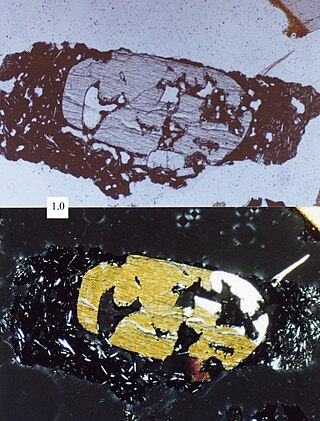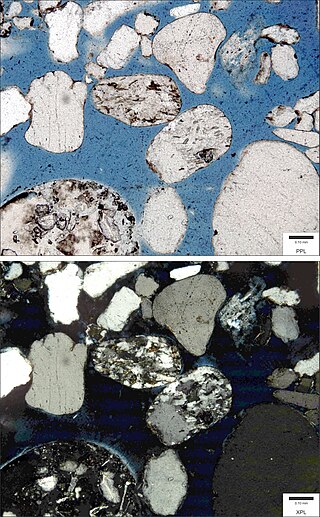
Sandstone is a clastic sedimentary rock composed mainly of sand-sized silicate grains. Sandstones comprise about 20–25% of all sedimentary rocks.

Sedimentary rocks are types of rock that are formed by the accumulation or deposition of mineral or organic particles at Earth's surface, followed by cementation. Sedimentation is the collective name for processes that cause these particles to settle in place. The particles that form a sedimentary rock are called sediment, and may be composed of geological detritus (minerals) or biological detritus. The geological detritus originated from weathering and erosion of existing rocks, or from the solidification of molten lava blobs erupted by volcanoes. The geological detritus is transported to the place of deposition by water, wind, ice or mass movement, which are called agents of denudation. Biological detritus was formed by bodies and parts of dead aquatic organisms, as well as their fecal mass, suspended in water and slowly piling up on the floor of water bodies. Sedimentation may also occur as dissolved minerals precipitate from water solution.

Greywacke or graywacke is a variety of sandstone generally characterized by its hardness, dark color, and poorly sorted angular grains of quartz, feldspar, and small rock fragments or sand-size lithic fragments set in a compact, clay-fine matrix. It is a texturally immature sedimentary rock generally found in Paleozoic strata. The larger grains can be sand- to gravel-sized, and matrix materials generally constitute more than 15% of the rock by volume.

Arkose or arkosic sandstone is a detrital sedimentary rock, specifically a type of sandstone containing at least 25% feldspar. Arkosic sand is sand that is similarly rich in feldspar, and thus the potential precursor of arkose.

In geology, a mélange is a large-scale breccia, a mappable body of rock characterized by a lack of continuous bedding and the inclusion of fragments of rock of all sizes, contained in a fine-grained deformed matrix. The mélange typically consists of a jumble of large blocks of varied lithologies. Both tectonic and sedimentary processes can form mélange.

A quartz arenite or quartzarenite is a sandstone composed of greater than 90% detrital quartz. Quartz arenites are the most mature sedimentary rocks possible, and are often referred to as ultra- or super-mature, and are usually cemented by silica. They often exhibit both textural and compositional maturity. The two primary sedimentary depositional environments that produce quartz arenites are beaches/upper shoreface and aeolian processes.

A QAPF diagram is a doubled-triangle plot diagram used to classify intrusive igneous rocks based on their mineralogy. The acronym QAPF stands for "Quartz, Alkali feldspar, Plagioclase, Feldspathoid (Foid)", which are the four mineral groups used for classification in a QAPF diagram. The percentages (ratios) of the Q, A, P and F groups are normalized, i.e., recalculated so that their sum is 100%.

William Richard Dickinson was a professor emeritus of geoscience at the University of Arizona and a member of the U.S. National Academy of Sciences. Prior joining the University of Arizona, Dickinson was a professor at Stanford University. He joined the U of A faculty in 1979.
The Folk classification, in geology, is a technical descriptive classification of sedimentary rocks devised by Robert L. Folk, an influential sedimentary petrologist and Professor Emeritus at the University of Texas.

Clastic rocks are composed of fragments, or clasts, of pre-existing minerals and rock. A clast is a fragment of geological detritus, chunks, and smaller grains of rock broken off other rocks by physical weathering. Geologists use the term clastic to refer to sedimentary rocks and particles in sediment transport, whether in suspension or as bed load, and in sediment deposits.

In geology, texture or rock microstructure refers to the relationship between the materials of which a rock is composed. The broadest textural classes are crystalline, fragmental, aphanitic, and glassy. The geometric aspects and relations amongst the component particles or crystals are referred to as the crystallographic texture or preferred orientation. Textures can be quantified in many ways. The most common parameter is the crystal size distribution. This creates the physical appearance or character of a rock, such as grain size, shape, arrangement, and other properties, at both the visible and microscopic scale.
This glossary of geology is a list of definitions of terms and concepts relevant to geology, its sub-disciplines, and related fields. For other terms related to the Earth sciences, see Glossary of geography terms.
Lithic fragments, or lithics, are pieces of other rocks that have been eroded down to sand size and now are sand grains in a sedimentary rock. They were first described and named by Bill Dickinson in 1970. Lithic fragments can be derived from sedimentary, igneous or metamorphic rocks. A lithic fragment is defined using the Gazzi-Dickinson point-counting method and being in the sand-size fraction. Sand grains in sedimentary rocks that are fragments of larger rocks that are not identified using the Gazzi-Dickinson method are usually called rock fragments instead of lithic fragments. Sandstones rich in lithic fragments are called lithic sandstones.

The Gazzi-Dickinson method is a point-counting technique used in geology to statistically measure the components of a sedimentary rock, chiefly sandstone. The main focus part of the technique is counting all sand-sized components as separate grains, regardless of what they are connected to. Gazzi-Dickinson point counting is used in the creation of ternary diagrams, such as QFL diagrams.

Lithic sandstones, or lithic arenites, or litharenites, are sandstones with a significant (>5%) component of lithic fragments, though quartz and feldspar are usually present as well, along with some clayey matrix. Lithic sandstones can have a speckled or gray color, and are usually associated with one specific type of lithic fragment.
The Thiviers-Payzac Unit is a metasedimentary succession of late Neoproterozoic and Cambrian age outcropping in the southern Limousin in France. The unit geologically forms part of the Variscan basement of the northwestern Massif Central.
The Vinini Formation is a marine, deep-water, sedimentary deposit of Ordovician to Early Silurian age in Nevada, U.S.A. It is notable for its highly varied, mainly siliceous composition, its mineral deposits, and controversies surrounding both its depositional environment and structural history. The formation was named by Merriam and Anderson for an occurrence along Vinini Creek in the Roberts Mountains of central Nevada and that name is now used extensively in the State.
Provenance in geology, is the reconstruction of the origin of sediments. The Earth is a dynamic planet, and all rocks are subject to transition between the three main rock types: sedimentary, metamorphic, and igneous rocks. Rocks exposed to the surface are sooner or later broken down into sediments. Sediments are expected to be able to provide evidence of the erosional history of their parent source rocks. The purpose of provenance study is to restore the tectonic, paleo-geographic and paleo-climatic history.
In north European geology, Jotnian sediments are a group of Precambrian rocks more specifically assigned to the Mesoproterozoic Era (Riphean), albeit some might be younger. Jotnian sediments include the oldest known sediments in the Baltic area that have not been subject to metamorphism. Stratigraphically, Jotnian sediments overlie the rapakivi granites and other igneous and metamorphic rocks and are often intruded by younger diabases.
Christopher Anne Suczek was a sedimentary geologist who specialized in sedimentary petrology and plate tectonics. She received her bachelor's degree from the University of California, Berkeley in 1972 and later went on to get her PhD in Geology from Stanford University in 1977. She is best known for her contribution in determining the correlation between sedimentary deposits and plate tectonics. By the 1980s the exploration of hydrocarbons and a continuation of tectonic studies in the Pacific Northwest area of the United States led to a need of increased knowledge of the Tertiary sedimentary basins and Suczek's mapping of the area.













